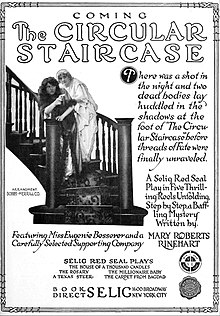
James Avery Hopwood was an American playwright of the Jazz Age. He had four plays running simultaneously on Broadway in 1920.

Dame Daphne du Maurier, Lady Browning, was an English novelist, biographer and playwright. Her parents were actor-manager Sir Gerald du Maurier and his wife, actress Muriel Beaumont. Her grandfather was George du Maurier, a writer and cartoonist.

Little Women is a 1994 American coming-of-age historical drama film directed by Gillian Armstrong. The screenplay by Robin Swicord is based on Louisa May Alcott's 1868–69 two-volume novel of the same title, the fifth feature film adaptation of the classic story. After a limited release on December 25, 1994, it was released nationwide four days later by Columbia Pictures.

Mary Roberts Rinehart was an American writer, often called the American Agatha Christie. Rinehart published her first mystery novel The Circular Staircase in 1908, which introduced the "had I but known" narrative style. Rinehart is also considered the source of "the butler did it" plot device in her novel The Door (1930), although the exact phrase does not appear in her work. She also worked to tell the stories and experiences of front line soldiers during World War I, one of the first women to travel to the Belgian front lines.

Dying Inside is a science fiction novel by American writer Robert Silverberg. It was nominated for the Nebula Award in 1972, and both the Hugo and Locus Awards in 1973.

The Bat is a 1959 American crime-mystery thriller starring Vincent Price and Agnes Moorehead. It is the fourth film adaptation of the story, which began as a 1908 novel The Circular Staircase by Mary Roberts Rinehart, which she later adapted into the 1920 play The Bat. The first film version of the play was the 1926 American silent film The Bat. The film version was adapted by playwright Crane Wilbur, who also directed.
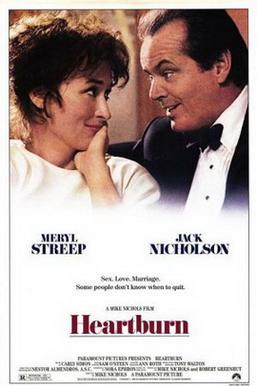
Heartburn is a 1986 American comedy-drama film directed and produced by Mike Nichols, starring Meryl Streep and Jack Nicholson. The screenplay, written by Nora Ephron, is based on her novel of the same name, a semi-biographical account of her marriage to Carl Bernstein. The film marked the debut of Kevin Spacey.
A spiral staircase is a type of stairway characterized by its helical shape
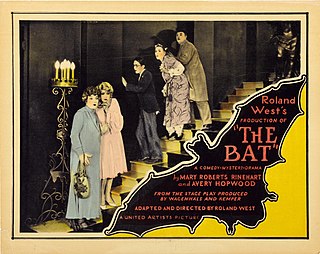
The Bat is a 1926 American silent comedy mystery film directed by Roland West and starring Jack Pickford and Louise Fazenda. The film is based on the 1920 Broadway hit play The Bat by Mary Roberts Rinehart and Avery Hopwood.
"Had I but known" is a form of prolepsis or foreshadowing that hints at some looming disaster in which the first-person narrator laments their course of action which precipitates some or other unfortunate series of actions.
Farrar & Rinehart (1929–1946) was a United States book publishing company founded in New York. Farrar & Rinehart enjoyed success with both non-fiction and novels, notably, the landmark Rivers of America Series and the first ten books in the Nero Wolfe corpus of Rex Stout. In 1943 the company was recognized with the first Carey-Thomas Award for creative publishing presented by Publishers Weekly.

Sons and Lovers is a 1960 British period drama film directed by Jack Cardiff and adapted by Gavin Lambert and T. E. B. Clarke from the semi-autobiographical 1913 novel of the same name by D. H. Lawrence. It stars Trevor Howard, Dean Stockwell, Wendy Hiller, Mary Ure, and Heather Sears.
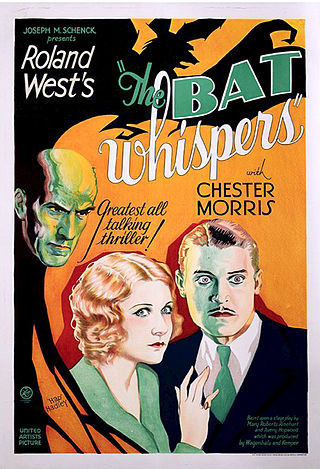
The Bat Whispers is a 1930 American pre-Code mystery film directed by Roland West, produced by Joseph M. Schenck, and released by United Artists. The film is based on the 1920 mystery play The Bat, written by Mary Roberts Rinehart and Avery Hopwood, and is the second film version by the same director, previously adapted in 1926. An early talkie and one of the first widescreen films, West financed the cinematography, which required two cameramen and several techniques. It was considered a lost film for many years, but was restored from duplicate filmstock in 1988.

Jump for Glory is a 1937 British crime romantic drama film directed by Raoul Walsh and starring Douglas Fairbanks Jr., Valerie Hobson and Alan Hale. It was based on a novel by Gordon McDonnell. The film was shot at Isleworth Studios by the independent company Criterion Film for distribution by United Artists. The film's sets were designed by the art director Edward Carrick.

The Bat is a three-act play by Mary Roberts Rinehart and Avery Hopwood that was first produced by Lincoln Wagenhals and Collin Kemper in 1920. The story combines elements of mystery and comedy as Cornelia Van Gorder and guests spend a stormy night at her rented summer home, searching for stolen money they believe is hidden in the house, while they are stalked by a masked criminal known as "the Bat". The Bat's identity is revealed at the end of the final act.
Roswolsky's Mistress is a 1921 German silent drama film directed by Felix Basch and starring Asta Nielsen, Paul Wegener, and Wilhelm Diegelmann. It was based on a novel by George Froeschel. The film was shot at the Tempelhof Studios in Berlin, with sets designed by art directors Robert Neppach and Jack Winter. According to one estimate, the star Asta Nielsen wore thirty six different costumes during the course of the film.
Seven Days is a three-act play written in 1909 by Avery Hopwood and Mary Roberts Rinehart. It is a farce based on Rinehart's 1908 novella of the same name, which had been expanded into a bestselling 1909 novel titled When a Man Marries. Producers Lincoln Wagenhals and Collin Kemper asked Rinehart to adapt the novella for the stage. Since she had not written a play before, she agreed to work with Avery Hopwood, a young playwright with just one produced play, to create the script. Wagenhals and Kemper staged the play at the Astor Theatre on Broadway, where it premiered on November 10, 1909. The production was a hit that played for 397 performances. The play's success led Hopwood to a highly successful career as an author of comedies and enabled Wagenhals and Kemper to retire.

Spanish Love is a three-act play by Avery Hopwood and Mary Roberts Rinehart, who adapted an earlier Spanish play, María del Carmen by Josep Feliu i Codina. Producers Lincoln Wagenhals and Collin Kemper staged it at the Maxine Elliott Theatre on Broadway, where it opened on August 17, 1920. Although critics had reservations about the play, the production was a success, running for over 300 performances. However, the play's success was overshadowed by the tremendous popularity of The Bat, another collaboration between Hopwood and Rinehart that opened on Broadway the following week.

The Circular Staircase is a 1915 mystery silent film directed by Edward LeSaint and starring Guy Oliver, Eugenie Besserrer, and Stella Razeto. The film was produced by the Selig Polyscope Company. It is based on the mystery novel of the same name by Mary Roberts Rinehart, which was originally published in five parts starting with the November 1907 issue of All-Story magazine. The film is now lost.
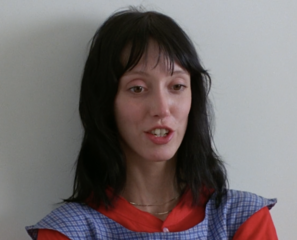
Winnifred "Wendy" Torrance is a fictional character and protagonist of the 1977 horror novel The Shining by the American writer Stephen King. She also appears in the prologue of Doctor Sleep, a 2013 sequel to The Shining.

